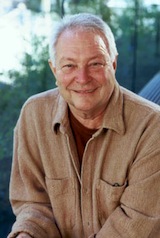Inouye's Trumpets to Cheer Melancholy Giants
This should be close to the (slightly broken) hearts of San Franciscans. It’s about musical support for the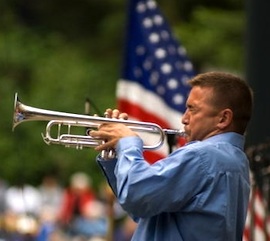 once-and-future World Champion Giants, last year’s Cinderella team, no longer in the running for the postseason, as of last weekend.
once-and-future World Champion Giants, last year’s Cinderella team, no longer in the running for the postseason, as of last weekend. Students of the city’s Conservatory of Music will serenade the Giants tonight, before their first game without stars in their eyes. The National Anthem by 10 trumpets is the brainchild of San Francisco Symphony principal trumpet Mark Inouye, whose performances in last week’s Mahler Third Symphony were greeted as “phenomenal” and “breathtakingly beautiful” ... for starters.
Inouye is an explosively multitalented young musician, equally at home with Mahler and jazz, and also a composer, teacher, and busy activist on behalf of all kinds of good (and seemingly lost) causes.
He has a special passion for the Giants, and on the SFS tour of Europe last year, he first started wearing the team’s miniature rally towel (in the breast pocket of his tux!), and then got the entire brass section to go orange.
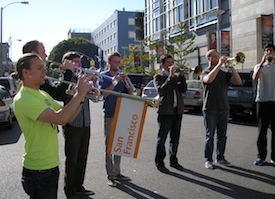
Tonight’s appearance in AT&T Park is only the first step in Inouye’s grand plan of performing in every major sports arena in the Bay Area. He has sent audition tapes to the Sharks, Warriors, and other teams.
Conservatory External Affairs Manager Sam Smith ventured into some internal reporting about what Inouye has been doing:
Mark personally coached the students in preparation for the audition and performance. When he stopped by our office on Thursday afternoon prior to pick up Conservatory hoodies for the students to wear, he was on his way to work with the trumpeters one last time before the game.As to all the praise heaped on him for the Mahler performances, this was Inouye’s response:A few of the students will play on herald trumpets on loan from San Francisco Opera, courtesy of Adam Luftman, principal trumpet with the Opera, friend of Mark Inouye as well as future Conservatory trumpet faculty (beginning the 2012–2013 school year).
At Mark’s initiative and expense, the Conservatory designed banners showing its logo to unfurl from the herald trumpets during the Star Spangled Banner. Mark bought a ticket for each student performer so they can stay for the duration of the game; he and co-faculty member David Burkhart will watch from the stadium’s free viewing area at the waterfront promenade.
The principal trombone of the orchestra [Tim Higgins] played phenomenally all week. It’s an honor to sit next to him and to be in the middle of an incredible back row of trumpets and trombones! It was a fun week.
Herbst Turns Sticky and Better
Against frequent admonitions in childhood, I tend to touch foreign objects on occasion. Saturday night, this potentially septic habit turned out to be helpful for activist journalism.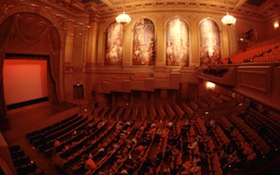
Totally enchanted by the New Century Chamber Orchestra’s stormy performance of Shchedrin’s Carmen Suite, I noticed that the sound is warmer and more immediate than during many years of frequenting Herbst Theatre — a venue that I and soprano Barbara Bonney like more than others. (Bonney at one time said Herbst is one of her favorite recital venues, on par with London’s Wigmore Hall.)
Is there something different in Herbst’s acoustics now? I went to the source of all things Herbst, House Manager Erik Nilsen. He was delighted to hear that the acoustical change was noticed, and explained what happened.

At the instigation of Philharmonia Baroque’s Peter Pastreich, Bott says, several changes have been made at Herbst, even as the theater — and the entire War Memorial Building — is getting ready for a major seismic renovation.
I thought the theater would be gutted, as was the Opera House, but apparently that won’t happen; the boxes will go, Bott saying that they’ve been useless both for hearing and for seeing — and not part of the original architecture. But that’s in the future.
What has already happened was removal of several salmon-colored panels from the walls inside the theater, their hard surface replaced by some sticky (and therefore absorbing) material. I didn’t quite get that, so Bott told me to go ahead and touch the wall. Eew, but what is a music journalist on the spot to do?
I touched, it’s sticky, go ahead and try it yourself. It does the job, and mellows the sound. Which is good.
Don’t worry about the eight Frank Brangwyn murals, leftovers from the 1915 Panama-Pacific International Exposition: They will stay. I am not crazy about them, but Bott — who lives with them — is enthusiastic, a real fan. When you touch the sticky walls below, stay away from the paintings above.
Philharmonia Baroque will enjoy the fruits of Pastreich’s minirenovation when it brings “Arias for Farinelli” to Herbst on Oct. 28.
Resignations in S.F. Girls Chorus Controversy
It was almost two months ago that the surprising news came from the San Francisco Girls Chorus that the contract of its popular and much-praised music director, Susan McMane, was not renewed, but the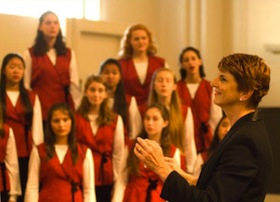 controversy is ongoing, even escalating.
controversy is ongoing, even escalating. Over the weekend several prominent members of the advisory board resigned in protest. Some of the information has been posted on the Web and on a “Save Susan” Facebook page, which includes a score of protests.
In a letter to board President Dorian Kingman Chong, who is also a former SFGC president and the spokesperson in the matter, James Meredith said the following:
By your own public admission, Susan has done everything asked of her, and more, meeting and exceeding expectations over her 10-year tenure. She was even highly praised by you at the recent gala. In that presentation it was acknowledged that she is highly respected by the local, national and international community for her artistic endeavors and her personal character. Shortly, after the gala, she was told that her contract would not be renewed. No discussion of why the board felt this was necessary was presented. Susan was only allowed to present her response to you at a follow-up meeting.Meredith, artistic director of the Sonos Handbell Ensemble, is a longtime collaborator with and former board member of the chorus. His note also mentions resignations by cellist Emil Miland and former San Francisco Symphony Chorus Director Vance George.A final 6 to 5 vote on this major issue by members present, with two resignations over the decision, is very telling. A board for this size organization needs to be larger and more representative than it currently is. ...
I would like to see the board postpone the contract decision, take some time to evaluate all of the community input, decide in great detail what you really want, counsel with professionals in the community as well as the artistic staff and then plan a substantial transition period if that is what you decide.
If you do not feel you can do this, then you should resign and let someone else take your places on the board. The whole process needs to be completely transparent to regain the respect and support of all of those who have a stake in the Girls Chorus. The fact that so many have raised concerns speaks to the esteem in which the organization is held. Do not trample lightly on that esteem.
George told Music News that his protest is against the “abrupt decision ... handled very badly by the board, staff and legal counsel.
“This economy has everyone in a twist. Suddenly people want to go in a different direction. A warning, some counsel and time should have been given to a person who has given so much to the chorus.
“A chorus is a living, breathing instrument. It is very human. Susan and the girls have been treated inhumanely. It is a matter of ethics and respecting the dignity of every human being that I object to. Boards and lawyers are notorious for this kind of treatment and in today’s world that is OK. They even make movies about it.”
The SFGC administration hasn’t responded to the new developments yet.
West Edge Opera Program Change
West Edge (née Berkeley) Opera is making a repertoire change well in advance, and being honest about the reasons:
“Due to a combination of budgetary constraints and the inability to cast the lead role appropriately, the previously announced production of Ezra Laderman’s Marilyn is being replaced.”
With yet another good deed, the replacement is not an old warhorse, but a fine double-bill of the Kurt Weill/Bertolt Brecht Mahagonny Songspiel and Daron Hagen’s Vera of Las Vegas, featuring Merola alumnus countertenor Brian Asawa.
The new program will conclude West Edge Opera’s 2011–2012 season on July 29 and Aug. 3 and 5, in El Cerrito High School. The season opens Oct. 30–Nov. 6 with Richard Strauss’ Ariadne auf Naxos, and continues March 4, 9, and 11, with David Scott Marley’s adaptation of Mozart’s The Magic Flute in Japanese animé style.
Mahagonny Songspiel is a one-act work premiered in Baden Baden in 1927. The 10 numbers, which include the “Alabama Song” and “Benares Song,” were later incorporated into the 1930 opera The Rise and Fall of the City of Mahagonny. Elkhanah Pulitzer will direct Mahagonny Songspiel and Jonathan Khuner will conduct.
Vera of Las Vegas tells the story of two ex-IRA operatives on the run from the INS and two rogue MI-5 agents. Due to a flight mishap, they are stuck in Las Vegas for a day, where they encounter a transvestite, Vera.
The work’s musical style blends cabaret, ’70s folk rock, Broadway, and modern classical “all fused together to create a unique and highly melodic score.” The title role is sung by Asawa. The cast includes tenor Thomas Glenn and soprano Heidi Moss. Mark Streshinsky directs and Khuner conducts.
Asawa will be also in evidence this week, when he and mezzo Diana Tash give a concert of Baroque opera, at 7 p.m., Sept. 29, in the Ruth Asawa School of the Arts Theater, at 555 Portola Drive, San Francisco. (The singer is sculptor Ruth Asawa’s nephew.)
The singers will be accompanied by cellist Josephine van Lier and harpsichordist Gilbert Martinez. For information and tickets, see the Web site.
Anyone Ready for an Audience of Six Million?
The San Francisco International Arts Festival is moving the 2013 season from May to July 10–Sept. 22, to coincide with the 34th America’s Cup. The organization will host a meeting for Bay Area artists and arts organizations at noon next Tuesday, Oct. 4, in Room 1185 of the Flood Building, 870 Market Street.Why the focus on America’s Cup? Because, race organizers predict, it will be the third largest sports event in the world, attracting between 40,000 and 200,000 visitors a day (the higher-end estimate on weekends). That adds up to about 6 million attendees over the length of the event. And, consider this: There are currently no official plans for a comprehensive cultural series to run alongside the races.
SFIAF Executive Director Andrew Wood says: “If you were hosting either of the first two largest sporting events in the world (the Olympics or the football World Cup), then creating an arts festival to be an integral part of it would be mandatory. A city is not allowed to even bid to host a World Cup or an Olympics unless it has extensive plans to incorporate a festival into the program.”
It looks like local arts organizations have some catching up to do.
Harbison Opera on Ensemble Parallèle Schedule
Another bit of opera news from next year — Feb. 10–12 — is Nicole Paiement’s Ensemble Parallèle presenting John Harbison’s The Great Gatsby in the Yerba Buena Center Theater.The cast includes Marco Panuccio, Jason Detwiler, Dan Snyder, Bojan Knezevic, Erin Neff, and San Francisco Conservatory graduate student Julienne Walker.
It will be the world premiere of chamber orchestration by Jacques Desjardins. Brian Staufenbiel will be stage director and production designer. Tickets go on sale at Yerba Buena on Oct. 1.
Based on the novel by F. Scott Fitzgerald, John Harbison’s Great Gatsby was originally commissioned by the Metropolitan Opera and premiered in 1999. Ensemble Parallèle’s production will bring the work to the stage for the first time in a decade.
Gilbert, Capuçon to Davies Symphony Hall with Dutilleux Concerto
New York Philharmonic Music Director Alan Gilbert, whose season-opening Mahler Second Symphony last week received high praise, is heading to San Francisco for two series of appearances.On Oct. 27–29, he will lead San Francisco Symphony subscription concerts; next May, he will bring the Philharmonic as part of the American Orchestras Series.
Next month’s concert will feature Renaud Capuçon as the soloist in Henri Dutilleux’s 1985 violin concerto L’Arbre des songes (The tree of dreams), in addition to Haydn’s Symphony No. 99 and Beethoven’s Symphony No. 8.
Nagano to Conduct Free Concert Honoring Gilchrist
Kent Nagano will conduct the San Francisco Academy Orchestra in a concert celebrating Alden Gilchrist’s 60th year as director of music at San Francisco’s historic Calvary Presbyterian Church.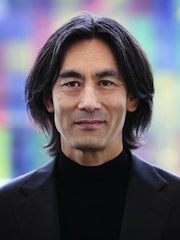
The concert, beginning at 6 p.m., Oct. 28, will include excerpts from Gilchrist’s own award-winning cantata, as well as works by Mozart, Dvořák, Monteverdi, and Bach, performed by the Academy Orchestra, the Calvary Chancel Choir and Soloists, and the Santa Rosa Children’s Chorus.
Soloists are Pamela Sebastian, Janet Campbell, Brian Thorsett, Jeff Fields, and Carol Menke, with Charles Worth as the accompanist. The Dave Scott Quartet will perform a jazz cycle.
The community is invited to the free concert, made possible by a grant from the Calvary Foundation, but is asked to RSVP by calling (415) 346-3832, ext. 60, or by e-mailing gilchrist60@calvarypresbyterian.org.
Memories of Sanderling
Kurt Sanderling died last week in Berlin, at age 98. He led the Leningrad Philharmonic and the East Berlin Symphony Orchestra under Soviet rule, and won admirers in the West later in his career as a guest conductor for orchestras in London, San Francisco, and elsewhere.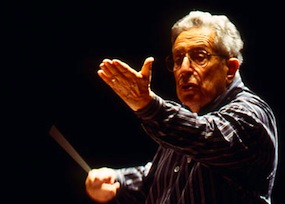
Charlie Cockey, now of Brno, but with the San Francisco Symphony Chorus back long ago, remembers Sanderling leading Beethoven’s Ninth Symphony in the Opera House:
He approached the piece explaining to us first that it was Friedrich Schiller whom he loved; Beethoven came later. So our approach was the words, and singing them with meaning, and speaking them properly. I think this was the performance for which Nora Norden came in and coached us as well.The beginning of our first rehearsal with him, fully prepped by Lou Magor, plus just about everybody in the group had sung the piece before, we were ready. I had no idea what to expect; Kurt Sanderling, somewhat short, aging stocky, at first looked so stern and imposing.
He sat down, turned and directed his attention to the bass/baritones. ‘Gentlemen. Your first entry — “Bruder!” — Let’s start there.’ One word, two syllables, a single note repeated, and Sonderling started working with them on those two notes — and working with them — and working with them. Over and over, just two sounds, the same note repeated, each time requesting something just a little different, something more he wanted here, the attack more such-and-so, this a bit less there. ...
It seemed like he worked with them on those two notes for a full half hour. I was singing tenor, and just try to imagine the intensity with which we, and all the women as well, followed this torture session the bass-baritones were being put through. What was he going to choose for us tenors? I was getting really nervous; we were all following every tiniest desire he had. Finally, he sat back, looked at the basses, said, ‘Good. Very good.’ Then sat fully back, looked at all the rest of us, smiled, and said, ‘OK. Now you all know what I want. Let’s SING!’ And we did, oh man, did we!
Piano Recital Opens Menlo Winter Series
Music@Menlo’s 2011–2012 Winter Series opens Oct. 2 with a recital by pianist Inon Barnatan, in the Center for Performing Arts at Menlo-Atherton.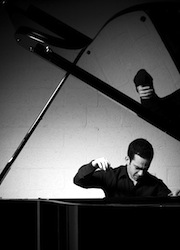
His program includes Thomas Adès’ 1992 Darknesse Visible, inspired by John Dowland’s 1610 song; Debussy’s 1905 Suite bergamasque; Ravel’s 1908 Gaspard de la Nuit; Britten’s 1972 Fantasy on Peter Grimes; and Schubert’s 1828 Sonata in A Major, D. 959.
Of the Adès piece, which is also the title of the recital, Barnatan says:
I have admired the music of Thomas Adès for many years, but this piece in particular is fascinating to me. When I first heard it, from the very first note, I knew I was going to play it. Adès took a beautiful song by John Dowland — ‘In Darkness Let Me Dwell’ — and exploded it! Not a single note or rhythm was changed, but what Adès managed to do, through the innovative use of tremolos and contrasting dynamics, and by changing the spacing of the notes, is turn it into a thoroughly modern and original piece. It’s hard to describe, but the effect is quite stunning, as if you are dreaming about the Dowland or floating inside it. The phrase ‘Darknesse Visible’ is taken from Milton’s Paradise Lost.Born in Tel Aviv in 1979, Barnatan started playing the piano at the age of 3 when his parents discovered he had perfect pitch; he made his orchestral debut at 11. He is now a U.S. resident, and next year he will embark on an eight-city European tour with cellist Alisa Weilerstein.
Meanwhile, Music@Menlo’s Artistic Directors David Finckel and Wu Han are off to a new venture in South Korea, where they are launching Chamber Music Today, a new festival that will take place annually in Seoul.
The inaugural festival will run Dec. 10–13, in the IBK Chamber Hall of the new Seoul Arts Center. One of the first festivals of its kind established in the Far East, Chamber Music Today is to play a vital role in Korea’s burgeoning chamber music scene. The inaugural season will present nine-time Grammy award–winning Emerson String Quartet and the Jupiter String Quartet, recent recipients of the Avery Fisher Career Grant. The festival will close with a performance by Finckel and Wu Han, joined by Emerson String Quartet violinist Philip Setzer.
Turturro's Passione About the Music of Naples
John Turturro’s Passione, described as “a wild, colorful, sexy ode to the music and people of Naples” opens Friday in the San Francisco Film Society’s New People Cinema.From lullabies to rock, contemporary love songs to traditional ballads, Neapolitan music has a vital history. In Turturro’s feature documentary, contemporary performances by singers such as M’Barka Ben Taleb and Lina Sastri are interspersed with footage of past masters Sergio Bruni, Renata Carasonni, and others.
Turturro is expected to attend the 7 p.m. and 9:30 p.m. screenings on Oct. 3.
New Music, Free, From Cincinnati
The Cincinnati Symphony Orchestra is offering five free digital downloads (introducing one per week for five weeks) of contemporary music performances on its Web site. The downloads are live recordings of the five Anniversary Fanfares commissioned last season by Ann and Harry Santen in celebration of Paavo Järvi’s 10th and final season as the orchestra’s music director.The works include Jonathan Bailey Holland’s Party Starter, Jörg Widmann’s Souvenir bavarois (Remembering Bavaria), Stewart Goodyear’s Count Up, Charles Coleman’s P.J. Fanfare, and Erkki-Sven Tüür’s Fireflower.

